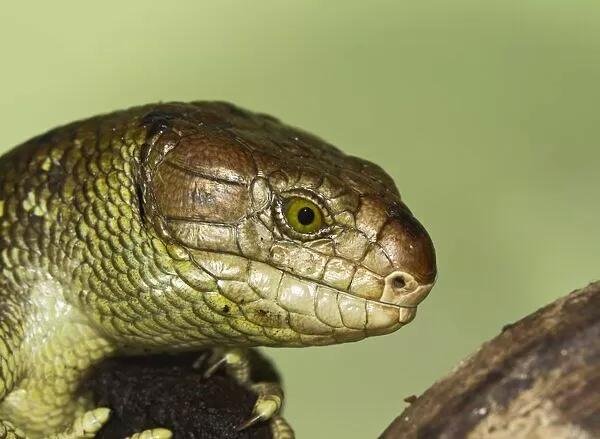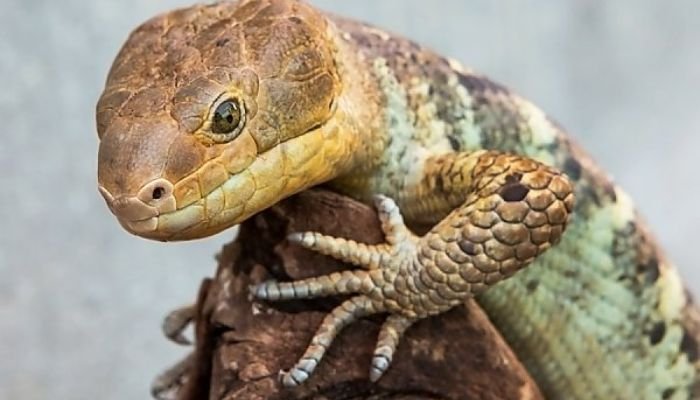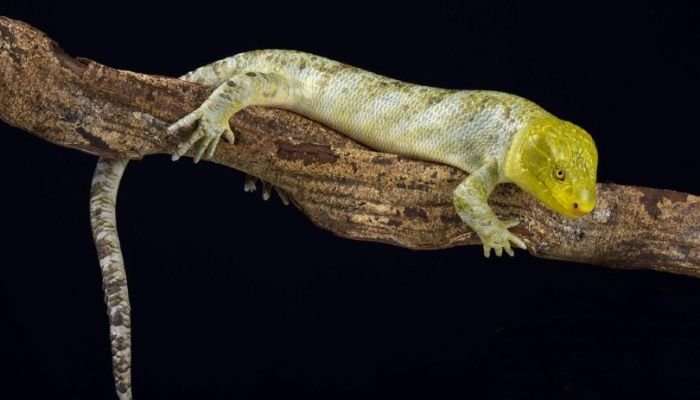
The rare Monkey-Tailed Skink inhabits the Solomon Islands and certain regions of Papua New Guinea. Due to its extraordinary appearance and long, prehensile tail, the Monkey-Tailed Skink is a highly sought-after reptile. It primarily inhabits trees and feeds on fruit, flowers, and foliage. The conservation of the Monkey-Tailed Skink is threatened by habitat degradation and collection for the pet trade. Their well-being in captivity is contingent on appropriate care, which includes providing a spacious and diverse habitat.. Here are Monkey-tailed skink Guide on Food, Habitat, Size, Lifespan & Predators below-
Monkey-tailed Skink Stats in Table format
The stats are given below for Monkey-tailed skink
| Reptiles List | Monkey-tailed skink |
|---|---|
| Family | Scincidae |
| Type | Lizard |
| Size | Large |
| Length | Monkey-tailed skink: Up to 24-30 inches (61-76 cm) |
| Color | Monkey-tailed skink: Typically has a brown or gray coloration with darker markings. |
| Weight | Monkey-tailed skink: Adult monkey-tailed skinks can weigh between 1 to 2 pounds.. |
| Lifespan | 20-30 years (or more) |
| Reproduction | Oviparous, lays eggs |
| Gestation Periods | The gestation period for a monkey-tailed skink is approximately 3 to 4 months. |
| Endangered Status | Not Evaluated (IUCN Red List) |
| Features | Prehensile tail, ability to regenerate tail |
| Country & Areas | Indonesia, Papua New Guinea, Solomon Islands, and Vanuatu. |
Monkey-tailed Skink Natural Habitat and Distribution
The deep tropical rainforests of the Solomon Islands are home to the majority of the world’s population of Monkey-tailed skinks. They are extremely adapted to life in the treetops, where they spend the vast majority of their time as arboreal species. The warm and humid weather of the islands is perfect for the survival of these reptiles.
Monkey-tailed Skink Physical Features and Adaptations
Here are some information about Monkey-tailed Skink
1. Body Structure
Adult monkey-tailed skinks, without counting their prehensile tail, can grow to be between 2.5 and 3 feet in length. Their stocky, muscular build, coupled with their strong limbs and sharp claws, makes them adept tree climbers. Their long, prehensile tail serves as a fifth limb for grasping branches, letting them to move deftly among the treetops.
2. Coloration and Patterns
These skinks are visually arresting due to the variety of colors and patterns found on their bodies. Their primary hue is a dark brown or black, and they often have lighter cream or yellow stripes running down their backs and flanks. The rough surface of their scales gives them an advantage while moving along vertical surfaces.
3. Defense Mechanisms
To ward against predators, monkey-tailed skinks employ a number of strategies. If they feel threatened, they may puff up, open their mouth wide, bare their sharp teeth, and hiss at the intruder. As an added measure of protection, they can drop their tail to draw the attention of a predator and make a quick getaway. Over time, the tail will grow back.
Monkey-tailed Skink Diet and Feeding Habits
Here are some information about Monkey-tailed Skink
1. Diet Type
As omnivores, monkey-tailed skinks consume both plant matter and insect and small animal prey.
2. Preferred Food Sources
Fruits, flowers, leaves, and other plant parts make up the bulk of their diet when they’re out in the wild. They also look for bird eggs and other small prey items.
3. Feeding Schedule
Diurnal animals, like monkey-tailed skinks, are awake and about during the day. Activity levels are the primary factor in determining how often they eat, which might be many times a day.
Monkey-tailed Skink Housing and Enclosure Requirements
Here are some information about Monkey-tailed Skink
1. Terrarium Size and Setup
The health and happiness of your Monkey-tailed skinks depends on your ability to provide them with a suitable habitat. Due to their arboreal lifestyle, a minimum of 4 square feet of vertical space, 3 square feet of horizontal space, and 2 square feet of depth is required for a single adult skink. When it comes to the size of the enclosure, though, more is usually better.

2. Substrate Options
In order to develop their climbing ability and prehensile tail, the enclosure should be furnished with thick branches and climbing structures that are reminiscent of their natural environment.
Organic potting soil, coconut coir, and cypress mulch would provide a great substrate for the cage. Humidity levels may be kept steady in this combination because of the soft and moist substrate.
3. Temperature and Lighting
Monkey-tailed skinks can’t live in a constant temperature environment. The cooler side of enclosure can be maintained at 75°F to 80°F (24°C to 27°C), while the basking region should be maintained at 85°F to 90°F (29°C to 32°C). A heat lamp can be used to create a basking area, and heat mats or ceramic heaters can be used for general heating.
These skinks require full-spectrum UVB illumination in order to produce vitamin D3, which improves calcium absorption and protects against metabolic bone disease (MBD).
4. Humidity and Water Needs
Because they evolved in a damp setting, Monkey-tailed skinks require constant high humidity. Humidity levels in their habitat should be between 70% and 80%. Humidity can be maintained by spraying the enclosure on a regular basis and providing a shallow water dish for drinking and soaking.
Monkey-tailed Skink Behaviour and Temperament
Here are some information about Monkey-tailed Skink Behaviour and Temperament:
1. Activity Levels
The daylight is when you’re most likely to see a monkey-tailed skink, as they are strictly diurnal. Much of their time is devoted to climbing, discovering new places, and hunting.
2. Social Behaviour
These skinks have a reputation for being alone in the wild. In captivity, however, they can live peacefully beside one another if given adequate room and food. To reduce the likelihood of hostility, it is important to make appropriate introductions.
3. Handling and Taming
These skinks are sensitive and may need time to adjust to human presence, so handling them requires caution and patience. Even if they have been handled frequently and gently since they were young, care must still be taken to respect their natural habits.
Monkey-tailed Skink Breeding and Reproduction
Here are some information about Monkey-tailed Skink Breeding and Reproduction:
1. Mating and Courtship Rituals
Males may blow out their bodies and show off their vivid colors to establish their authority during the breeding season. For the same purpose, they may engage in head-bobbing and other courtship rituals.
2. Incubation and Hatchlings
Once the female has reached the gravid stage, she will lay eggs that will require incubation. The eggs need to be transferred to an incubator where they can be kept at the correct temperature and humidity. The eggs will hatch after a period of time, and the young will emerge.
Monkey-tailed Skink Common Health Issues and Veterinary Care
Here are some information about Monkey-tailed Skink Common Health Issues and Veterinary Care
1. Respiratory Infections
Monkey-tailed skinks are susceptible to respiratory diseases if housed in conditions that are too hot or too dry. Problems with breathing might manifest as coughing, wheezing, or the formation of bubbles in the oral cavity.
2. Parasites
Parasites, both internal and external, can affect Monkey-tailed skinks, as they can many other reptiles. The best way to detect and cure parasite infestations in reptiles is to have them examined by a reptile vet on a regular basis.
3. Metabolic Bone Disease
Captive reptiles, particularly Monkey-tailed skinks, are at risk for MBD. Weakened bones and other health problems are the result of a lack of calcium and vitamin D3.

Importance of Regular Vet Check-ups
Monkey-tailed skinks require routine checkups with a specialized reptile vet to ensure their continued good health. A veterinarian may do in-depth examinations, diagnose potential problems, prescribe appropriate treatments, and offer helpful guidance on care and diet.
Conclusion:
The tropical rainforests of the Solomon Islands are ideal for the survival of the amazing reptiles known as monkey-tailed skinks because of their special traits and adaptations. its capacity to adapt to different environments is shown in characteristics like as its prehensile tail, arboreal lifestyle, and varied diet. These fascinating animals require special attention to their housing, nourishment, and health in order to thrive in captivity. In order to give these incredible reptiles the best chance at a long and happy life, it is incumbent upon us as responsible keepers to put their health and happiness first and seek professional veterinarian care when necessary.
FAQs
Q: What is the family and Type of a Monkey-tailed skink?
A: The Monkey-tailed skink is a species of family Scincidae. The Famous Monkey-tailed skink is a member of the family Lizard.
Q: What is the average size of a Monkey-tailed skink?
A: The average adult Monkey-tailed skink is Large between Monkey-tailed skink: Up to 24-30 inches (61-76 cm).
Q: How long can a Monkey-tailed skink grow in size in lengths?
A: Monkey-tailed skink is Large in size and The monkey-tailed skink can grow up to an impressive length of 24-30 inches (61-76 cm).
Q: What colors do Monkey-tailed skink come in?
A: The monkey-tailed skink is known for its beautiful brown or gray coloration, which is adorned with darker markings..
Q: How big can a Monkey-tailed skink get in weight?
A: The adult monkey-tailed skinks typically have a weight range of 1 to 2 pounds.
Q: What are the special Features of a Monkey-tailed skink?
A: Monkey-tailed skink are Prehensile tail, ability to regenerate tail
Q: How long do Monkey-tailed skink live?
A: The usual lifespan of an Monkey-tailed skink is The monkey-tailed skink has a lifespan of around 20-30 years, and in some cases, they can live even longer.
Q: What food does the Monkey-tailed skink eat?
Insects including crickets, mealworms, and roaches make up the bulk of the monkey-tailed skink’s diet. Lizards and small mammals are among the vertebrates they may eat. They also occasionally consume fresh produce. Their diet is predominantly meat, but they do eat some vegetables.
Q: What is the best habitat for a Monkey-tailed skink?
A: A monkey-tailed skink would do best in a tropical rainforest. These skinks were adapted to the warm, humid environment of the New Guinean rainforests, where they were first discovered. As arboreal animals, they need a spacious enclosure with enough of trees to climb. Live plants and branches for them to climb on should fill the habitat to a high density. To sustain the high humidity levels they require, a water element such as a shallow pool or misting system is required. The skink needs to be able to control its body temperature by moving between warm sections of the cage (the basking spot) and colder areas (the rest of the enclosure). The optimal environment for a monkey-tailed skink is a tropical rainforest that is regularly maintained by experts.
Q: How do Monkey-tailed skink give birth?
A: Monkey-tailed skink are Oviparous, lays eggs
Q: How long is the gestation period for a Monkey-tailed skink?
A: The gestation period of a Monkey-tailed skink is approximately The gestation period for a monkey-tailed skink is approximately 3 to 4 months.
Q: What is the natural behavior of a Monkey-tailed skink?
Most monkey-tailed skinks are female, hence the answer is The monkey-tailed skink, also called the Solomon Islands skink, alternates between arboreal and terrestrial lifestyles in its natural environment. Using their prehensile tails, these reptiles spend the vast majority of their time in the forest canopy. Diurnal in nature, these animals eat a wide range of insects, fruits, and even some small vertebrates. The tails of monkey-tailed skinks can regrow when they are lost as a protection strategy. They typically live in pairs or small groups due to their gregarious nature. In order to woo potential mates during mating season, men will often perform aggressive territorial displays. The monkey-tailed skink is successful in its native environment because of a variety of activities.
Q: Is the Monkey-tailed skink endangered?
A: The Monkey-tailed skink is Not Evaluated (IUCN Red List).
Q: What are the prey of Monkey-tailed skink?
A: The prey of the monkey-tailed skink includes insects, spiders, small reptiles, and occasionally small mammals..
Q: Do Monkey-tailed skink have any Predators?
Skinks with monkey-like tails Birds of prey like hawks and owls, as well as snakes and larger lizards, are among the monkey-tailed skink’s natural enemies. The skink is an easy prey for these animals because of its small size and lethargic mobility. The monkey-tailed skink may also be preyed upon by foxes and cats if given the chance.
Q: How Fast Does Monkey-tailed skink Move?
A: The monkey-tailed skink can move at a fast speed, using its long tail to help it climb trees and navigate its environment.
Q. What is Bite Force of Monkey-tailed skink in PSI?
A. Bite Force in PSI is a measure of the strength of a monkey-tailed skink’s bite.
Q: Can we keep Monkey-tailed skinks as pets?
The answer is yes; monkey-tailed skinks make great pets. They are little lizards that can only be found in New Guinea, but their distinct look and calm demeanor have made them popular. Those who are interested in reptiles can have wonderful pets if they are handled properly.
I hope you like reading on Monkey-tailed skink FAQ Guide on Food, Habitat, Size, Lifespan and Predators.
